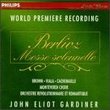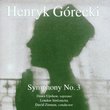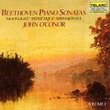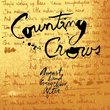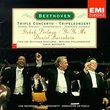| All Artists: Ludwig van Beethoven, Pierre-Laurent Aimard, Nikolaus Harnoncourt, Chamber Orchestra of Europe Title: Beethoven: Piano Concertos Nos. 1-5 Members Wishing: 0 Total Copies: 0 Label: Teldec Release Date: 5/20/2003 Genre: Classical Styles: Forms & Genres, Concertos, Historical Periods, Classical (c.1770-1830), Instruments, Keyboard, Symphonies Number of Discs: 3 SwapaCD Credits: 3 UPC: 809274733429 |
Search - Ludwig van Beethoven, Pierre-Laurent Aimard, Nikolaus Harnoncourt :: Beethoven: Piano Concertos Nos. 1-5
 | Ludwig van Beethoven, Pierre-Laurent Aimard, Nikolaus Harnoncourt Beethoven: Piano Concertos Nos. 1-5 Genre: Classical
Aimard is best-known as an exponent of contemporary music, Harnoncourt, as a Founding Father of the period instrument movement. Both bring elements of their contrasting backgrounds to this provocative set: Aimard, in the l... more » |
Larger Image |
CD DetailsSynopsis
Amazon.com Aimard is best-known as an exponent of contemporary music, Harnoncourt, as a Founding Father of the period instrument movement. Both bring elements of their contrasting backgrounds to this provocative set: Aimard, in the lucidity and transparency of his playing, Harnoncourt, by rooting Beethoven within earlier traditions. But such templates don't always apply here, since they also utilize such ultra-Romantic gestures as wide tempo fluctuations, often from one measure to the next, elongated pauses, unexpected accents, among others. Such a diversity of interpretive stances takes getting used to, but the effort's worthwhile as these discs make something fresh and new out of familiar repertory pieces. The first two concertos fare best, and the "Emperor" is also striking with its blend of clear textures and heroic gestures that likely surprised the composer's contemporaries with their boldness. In No. 3, lyricism sometimes shades into lingering, and the famous dialogue between growling orchestra and poetic piano in No. 4 is tame alongside most versions. Overall, the pair generally favor spacious tempos--the opening Allegro con brios of the first three concertos don't have much brio, and slow movements are slower than the norm, although those fluctuating internal speeds keep total timings within the "normal" range. But then, the goal of these artists is to restore a spirit of adventure and spontaneity to Beethoven, and they've certainly succeeded. --Dan Davis Similarly Requested CDs
|
CD ReviewsA Stunning Collaboration J Scott Morrison | Middlebury VT, USA | 08/16/2003 (5 out of 5 stars) "I often like to hear what pianists who specialize in contemporary music have to say about pieces from the established repertoire; they tend to re-think even the old works. This, plus a recommendation from a friend, led me to buy this set featuring Pierre-Laurent Aimard. I had heard him play part of Messaien's 'Vingt Regards' this past season and was knocked out. Then I got his recording of the Ligeti Études and was convinced by them that he is one of the most talented pianists today, at least in modern repertoire. I had heard rumors that Nikolaus Harnoncourt, having recorded a very successful Beethoven symphony set with the Chamber Orchestra of Europe, was planning to record the Beethoven Piano Concerti with them as well and I'd heard it was going to be with Martha Argerich. I later read, though, that she refused to participate at least partly because she didn't know all five of the concerti and didn't want to learn the ones she didn't already know. When I heard that the project was going ahead, but with Aimard, I was puzzled but very interested. In the set's booklet, Aimard indicates that although he had never performed with Harnoncourt, the conductor had heard him play a Beethoven sonata in recital and judged that he might make a wonderful collaborator. Aimard was, understandably, a bit surprised at being chosen, but quickly agreed to the project. These recordings, then, were taken, except for the recording of the Second Concerto, from live performances in Harnoncourt's hometown, Graz, Austria; the Second was recorded live in the Vienna Philharmonic's home hall, the Musikverein. The 3-CD set presents the concerti in the order in which they were written: 2, 1, 3, 4, 5.There are a number of general comments to make about this collaboration. First, it is clear that both Harnoncourt and Aimard have re-thought the pieces from start to finish. There are not simply gazing admiringly at well-known monuments. They are getting up-close-and-personal and making observations, individually and together, that are fresh and new. Further, their cooperation is stunning; Harnoncourt, whose long-standing relationship with the COE is such that he can get anything he wants from them with a flick of the wrist, conducts the pieces as if the music were occurring to him in the now. This means that there are many tempo alterations, pauses, accents, mouldings of phrases that sound spontaneous. And Aimard matches him gesture for gesture. Occasionally this is irritating, but usually it is simply surprising and enlightening. One thing is for sure: you never know what is just around the next corner. And this, of course, makes the music fresh and exciting. Following along with score I noted no flagrant disregard of Beethoven's notated indications, and indeed I saw that Aimard followed quite closely such things as Beethoven's sometimes quirky but always effective pedal markings and accents.The COE, as a result of Harnoncourt's background in early music, uses minimal vibrato, the winds and brass sound like original instruments (although I don't know whether they actually are), the timpani are crisp (from leather-headed sticks?) as they were in the Harnoncourt/COE symphony set. The sound picture is exceptionally clear and the dynamic range exceptionally wide. The sound of the piano is not nearly as highlighted as it is in most concerto recordings; rather it sounds like it does in a concert hall. This seems particularly so in the latter two concerti. This strikes me as apt, since the Fourth is a rather like a symphonic fantasia with piano obbligato and the Fifth--in distinction to its usual presentation as a grand Romantic concerto with heroic piano solo--is a symphony with piano. For this reason, the Fourth and Fifth are particularly successful.The slow movements are generally slower than usually heard, and they all feature heavenly string playing from the COE. The muted strings in the slow movement of the Fifth are matched by Aimard's slightly covered sound and the effect is heavenly. One doesn't want it to end, but when the final chord in B major resolves downward to the B flat opening of the final movement it is like waking from a dream to find oneself in a fresh and wonderful new world--one of Beethoven's master-strokes served up perfectly by Harnoncourt and his musicians. The colloquy--one might say 'debate'--between the piano and the orchestra in the middle movement of the Fourth is more genial than in some performances, but this is in the interest of a rather gentler overall approach in that concerto, one that I find attractive. The Second concerto, usually played as a Haydnesque late-Classic concerto, is more full-blooded than one generally hears; this may be partly due to the rich, warm ambience of the recording venue, the Vienna Musikverein. Whatever the reason, I like this approach; I've often thought other performances have drained this concerto of its fire, focusing rather on its music-box features.The First concerto in C major is, for whatever reason, my least favorite of the five, but it is given a loving, nuanced, sparkling performance here. The outer movements of the Third, in C minor, are the weakest of the set--although the performances are not at all bad; the sound is a little muddy as well. Its middle movement, though, one of Beethoven's loveliest movements, is perfect. Its stillness foreshadows the slow movements of Beethoven's late sonatas and quartets. Harnoncourt and Aimard are in complete accord on its extremely slow tempo and time seems to stand still. In summary, then, this is one of the most successful Beethoven Concerto sets I've ever encountered. I would not want to be without Arrau/C. Davis (my favorite over the years), or various recordings by Gilels, Richter, Brendel, Ashkenazy, Kovacevich, Schnabel (that glorious Fifth with the Chicago Symphony!) and others. For new insights, though, and a slightly out-of-the-mainstream approach, as well as a deep satisfaction, I'll reach for this set often, I suspect.Heartily recommended. CD1=70;24 (2nd=31:10, 1st=39:14) CD2=37:50 (3rd) CD3=75:09 (4th=35:27, 5th=39:42) TT=183:19Scott Morrison" Splendid Beethoven From Aimard, Harnoncourt And COE John Kwok | New York, NY USA | 07/20/2003 (5 out of 5 stars) "Pianist Pierre-Laurent Aimard and conductor Nikolaus Harnoncourt have yielded a sterling series of performances in this latest set of Beethoven piano concerti. Theirs is a striking contrast in styles, between Aimard's modernist view of piano performance and Harnoncourt's interest in period instrument performance, which works rather well in most of the concerti. Oddly enough, their successful collaboration yields a startling, often invigorating, Romantic view of Beethoven's works, accentuating sharp contrasts in tempi, accents and rests (pauses). Their collobration succeeds admirably in the first two piano concerti, and especially, in the celebrated 5th "Emperor" concerto in E Flat Major; their performance of the "Emperor" is both the most idiosyncratic and vibrantly fresh version I have heard in some time. Unfortunately the 4th Concerto lacks the dramatic dialogue between soloist and orchestra that it's noted for (Though judging from the linear notes this is obviously not their intent.), but it is still a splendid performance. The weakest performance is probably the 3rd piano concerto, which isn't as elegantly played as those I've heard in other versions from Brendel (His early 1980's Philips cycle with James Levine conducting the Chicago Symphony Orchestra) or Perahia with Bernard Haitink conducting the Royal Concertgebouw Orchestra. Aimard's playing of the opening measures of the 4th Concerto's 1st movement (Allegro Moderato) is the quietest, most poetic I've come across. His performances are lucid, pensive, persuasive accounts that lack the flair we've come to expect from the likes of Kovacevich, Perahia, Pollini and Schiff, among others. Yet by no means do they lack the drama and lyricism heard in recordings by these soloists, or others such as Arrau, Brendel and Uchida. Yet his playing never overshadows the Chamber Orchestra of Europe, led ably by Harnoncourt in lyrical, vibrant performances of Beethoven's scores. Indeed, theirs is an equal collaboration amongst soloist, conductor and orchestra. The concerti are organized in this collection in the order they were composed by Beethoven, so the 1st Piano Concerto (which was composed after the 2nd concerto) is on the second half of the first CD. Virtually all of the concerti were recorded in Harnoncourt's hometown of Graz, Austria, in the same concert hall where he and the Chamber Orchestra of Europe recorded his celebrated Beethoven symphony cycle nearly a decade before. The sole exception is the 2nd Concerto, which was recorded in Vienna's Musikverein, the Vienna Philharmonic's concert hall (The hall's warm, ambient acoustics certainly count for the richness of the sound; whereas in the others, the recordings sound as though they were made in a small concert hall, yet still retain the rich dynamic range heard in the recording made in the Musikverein.). Although this new CD collection will not immediately replace those I have with Arrau (His second Philips cycle with Sir Colin Davis conducting the Dresden Staatskapelle), Kovacevich, Perahia and Schiff, it does deserve recognition as an important, novel re-examination of Beethoven's piano concerti. Without question, it may be the best recorded version currently available. The sound quality wrought by Teldec's engineers is first rate, coming close to the technical triumphs yielded by Deutsche Grammophon's engineers in recent years. Fans of Aimard and Harnoncourt will treasure these fine recordings, but I also strongly recommend them to those who would ignore them because they lack the dramatic tension between soloist and orchestra prevalent in numerous recordings of the Beethoven piano concerti cycle." Recordings at the styriarte festival in Graz infostyriarte | Graz, Austria | 11/03/2003 (5 out of 5 stars) "I'm glad that other listeners enjoy this recording of Beethoven's piano concertos as much as I do. I just wanted to correct some false information about the recording details: In the booklet of the CD you can read that the 2nd concerto was recorded in Vienna which isn't true. This concerto was recorded in Graz at the styriarte festival 2001 (June-July), whereas the first concerto was recorded in Vienna. In order to complete the series in Graz Nikolaus Harnoncourt and Pierre-Laurent Aimard decided to do the first concerto in 2003, but it was not recorded by Teldec/Warner at the festival 2003. Instead Warner took the older recording from Vienna. What Warner did record in Graz at the festival 2003 was Beethoven's Choral fantasy op. 80 and the Rondo, WoO 6.
Apart from pointing out these technical details of the recording I warmly recommend a live performance of Nikolaus Harnoncourt, Pierre-Laurent Aimard and the Chamber Orchestra of Europe because the CD can not grasp the overwhelming atmosphere which these great artists produce in Nikolaus Harnoncourt's hometown." |

 Track Listings (6) - Disc #1
Track Listings (6) - Disc #1

